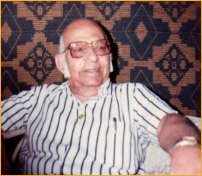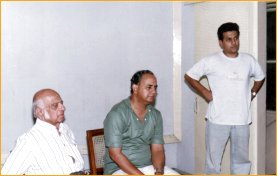 |
  |
 |
  |
S C GANDHI - THE WIZARD OF SOUND by Pushpakant Panchal e-mail: karc12@yahoo.com Nov 2002  Born on Jan 12, 1919 with an education of matriculation in Mumbai, S C Gandhi started his career at the age of 15. He joined Filmistan Studios as an apprentice in the sound department. There he came into contact with C E Biggs who became his mentor since then. Biggs and Gandhi travelled together to Madras and joined Pragathi Studios run by A V Meiyappa Chettiar. There he had the opportunity to record the music of greats like M K Thyagaraja Bagavathar and T R Mahalingam to name a few. A notable film of that time was "Vedala Ulagham" which went on to celebrate its Diamond Jubilee . In the early 40's, Gandhi and Biggs joined Motion Pictures Combines of South India. This studio was taken over by S S Vasan and renamed as Gemini Studios. From its inception to almost its closure in 1975, Gandhi worked in the sound department in various capacities, till he became the sound engineer. Under the tutelage of Biggs he learnt the intricacies of the trade to the fullest, from recording to repairing the equipments. This versatility was rare, as not many recordists of that time could boast of these rare skills. There are many interesting work experiences in his career in film music recording. During the recording of "Avaiyar", a sequence where a herd of elephants are seen battering a fortress wall, needed an effect, which was gigantic in proportions of sound. In those days, they invented a way to layer a single elephant trumpet into many and then keeping a slight delay in between, to reach the desired effect without any loss in quality. We have to keep in mind that, all recording then was done live on film, so they had to do the layering and printing again and again. Of course their greatest hit was "Chandralekha". This film took a couple of years in the making and featured the famous drum dance. It was a marvel of sound engineering considering the fact that only 4 tracks were used for recording simultaneously on to magnetic film. This film grossed a staggering Rupees One Crore in those days. Other films in which Gandhi lent his skills, just to name a few are "Apoorva Sagothargal" {Tamil, "Nishan " {Hindi}, "Insaniyath" {Hindi}, "Paigham" {Hindi}, "Sansar " {Hindi}, "Zindagi" {Hindi} and "Avaiyar" {Tamil}.  It was Gandhi who recorded the maiden songs of playback singers PB Sreenivas and Seergazhi Govindarajan. S S Vasan, a demanding producer, would OK a take only when his sound department gave the nod. Even greats like Dilip Kumar were made to do retakes several times despite his displeasure, but such was Gandhi's greatness that Dilip Kumar appreciated the end result and personally lauded Gandhi after the film's release. The quality of sound was so perfect that R C A Engineers recommended a reel of Gemini Studios to be a test track for Theatre Reproduction Standards. In 1976, after the closure of Gemini Studios, Gandhi started a small private studio called Kalpana Arts Recording Centre. Here, he worked ceaselessly, recording many a famous jingle and advertisement, audio-visuals, song albums etc. He recorded the famous radio serial "Suchitravin Kudumbam" by Horlicks. This serial ran for a record 252 weeks over five years. He was so techno savvy, many came to know of the existence of the famous Shure mike only through Gandhi. Anita Ratnam still remembers Gandhi recording her pop music program on a spool when she was a teenager, a spool she still treasures. Some famous names of today like Bombay Jayshree and Malgudi Shuba had recorded jingles at Gandhi's studio at the start of their career. Many a recording for dance music has been done in Gandhi's studios, as it is popularly referred to. The clarity and precision of sound and the superb mixing, done those days in spools, is retained even to this day. Gandhi knew exactly how to balance voice, percussion and other instruments. At a time when not much technical expertise was available, Gandhi used just his two ears and wealth of experience in producing the fantastic balance and clarity of sounds, so essential for a dance performance. Gandhi has recorded for almost all prominent figures in the field of Bharatanatyam, like Adyar K Lakshman, Trichur Ramanathan, Madurai T Sethuraman, Seetharama Sharma of Kala Peetam, Nandini Ramani, Leela Samson, Vyjayanthimala, and Anita Ratnam. Music for Kalakshetra productions has been recorded here in the 80's. Most of the recordings done at Gandhi's Studio were for performances outside India. Not only artistes from within India, but also many regulars from abroad sought the expertise of Gandhi. Naidu, a dapper gentleman from South Africa made his recordings at Kalpana Arts every time he visited Chennai. The 2 shared such a warm friendship that even when he was 90, Naidu used to address Gandhi as 'baba'! Bharatanatyam dancer Miako from Japan comes every year to record music for her items at Gandhi's Studio. Bharatanatyam guru Narasimhachari does his music editing here. The list is endless. As a youngster observing and learning the trade, a couple of instances come to my mind about my grandfather's genius in recording music for dance. The music for 'Chandalika' was originally recorded at Mehboob Studios with famous musicians like Pt. Ravi Shankar and others. When Vyjayanthimala wanted to perform it in Chennai a couple of years back, the re-editing and digitizing was done by Gandhi. In another instance, dancer Leela Samson wanted to insert the talam sound into a portion of an already recorded music. There were no tracks then, only spool recording. Gandhi replayed the music on to another tape and when he gave the signal, Leela Samson danced and the salangai sounds were incorporated with the cross fading technique. No one hearing the tape would have guessed that the salangai was a later addition. The sound of the nattuvangam is very loud and overshadows all other instruments. Gandhi used a mild insulation tape to separate the vibrations, and the artist had to do the nattuvangam under an overturned chair. This helped to record the correct sound without the beat being too loud and suppressing the other instruments. Gandhi was truly a wizard of sound. A friend, philosopher and guide to so many in and out of the field, he was at work even two days prior to his demise on 13th Oct 2002. Pushpakant has been working all along with his grandfather and acquired the expertise. He runs Kalpana Arts Recording now. Pushpakant "Kalpana Arts Recording Centre" 28, Eldams Road Chennai 600018 Ph: (044) - 4350226 e-mail: karc12@yahoo.com |